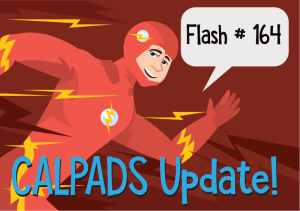CALPADS Update FLASH #164
Postsecondary Status File
The CALPADS File Specifications (CFS) includes a new file, the Postsecondary Status (PSTS) file that will be implemented in 2019–20. This file will be used by LEAs to submit survey data to CALPADS that LEAs previously submitted to the CDE through the Perkins Data System (PDS) and the California Special Education Management Information System (CASEMIS), both of which are now retired. LEAs have generally collected the postsecondary status data for Career Technical Education (CTE) pathway completers and concentrators, and students with disabilities (SWD) who have completed secondary education, through a student survey. LEAs will now submit the data they have collected to CALPADS twice a year. During Fall 2, LEAs will submit data collected for CTE completers only who exited secondary education in 2018–19, and during End-of-Year (EOY) 4, LEAs will submit data collected for SWD who have completed secondary education in 2018–19. This FLASH focuses on the submission of data for CTE pathway completers.
Reporting Postsecondary Status for Career Technical Education
This FLASH summarizes how LEAs will report the postsecondary status for CTE completers using the new PSTS file. All LEAs that reported CTE pathway completers are required to report this data for all CTE completers, regardless if the LEA receives federal Perkins funding.
The Strengthening Career and Technical Education for the 21st Century Act (Perkins V), previously known as the Carl D. Perkins Career and Technical Education Improvement Act of 2006 (Perkins IV), modifies federal reporting requirements and establishes new CTE performance indicators. The CDE is in the process of developing a new state plan that must be approved by the State Board of Education and then submitted to the United States Department of Education (ED). Accordingly, over the next two years, the CDE will be modifying the collection of CTE data and the CALPADS CTE reports to reflect these changes. Fortunately, the new requirements are aligned with reporting under the federal Every Student Succeeds Act (ESSA) and will therefore simplify data collection and reporting for CTE.
The CDE will be implementing the new postsecondary status collection, previously referred to under Perkins IV as the "E-2" collection, in a manner that reflects Perkins V. This data will be used to help develop the "Post-Program Placement" indicator under Perkins V. LEAs will report this data for the first time through CALPADS as part of the 2019–20 Fall 2 data submission, as follows:
What is the data used for?
The Perkins V performance indicators are largely based on students in the 4-year Adjusted Cohort Graduation Rate (ACGR). The data collected on the PSTS file will be used to calculate the 3S1 – Post-Program Placement indicator.
The Post-Program Placement Indicator will be calculated as follows:
Numerator: The number of CTE completers in the 4-year ACGR who are employed, or in postsecondary education, advanced training, military service or service program, or Peace Corps
Denominator: The number of CTE completers in the 4-year ACGR
Who should LEAs survey?
LEAs should survey CTE pathway completers, as currently defined, who were in the 2018–19 4-year ACGR, exiting secondary education in 2018–19. This should include any student who was a CTE pathway completer at any time during high school, and left 12th grade in 2018–19 with a School Completion status of:
- Graduated, standard HS diploma (1)
- Students with Disabilities Certification of Completion (120)
- Adult education high school diploma (250)
- Received a High School Equivalency Certificate (320)
- Passed CHSPE (and no standard diploma) (330)
- Completed grade 12 without completing graduation requirements, not grad (360)
LEAs can to refer to the students in the CALPADS 2018–19 report 15.2, referred to as the "Cohort report." This report can be found in the Reports menu in CALPADS under Accountability Reports. To determine which of the students in the cohort were CTE Completers, LEAs can run Snapshot Report 3.15 – Career Technical Education Concentrators and Completers – Student List, and filter as follows:
- Grade: 12
- CTE Participant Type: Completers
- Perkins/CTEIG Fundable: All
To identify students in this cohort who may have been a CTE completer in a prior year, LEAs would need to run Snapshot Report 3.15 for prior years (at least 2018–19) to identify any students in the cohort who were CTE completers in a prior year. Alternatively, LEAs may identify these students through their student information system (SIS) if maintained by those systems. In this first year of submitting this data through CALPADS, the CDE requests that LEAs do their best to capture CTE pathway completers from years prior to 2018–19. In the future, the CDE will try to provide this information on a report.
When should LEAs survey students?
LEAs should survey students in the second quarter following the end of the 2018–19 school year, which will be some time during December 2019 – January 2020.
How is the survey conducted?
Each LEA mush establish a process to capture the postsecondary status of the specified students. Generally, LEAs conduct some type of student survey. Some SIS and/or special education data systems (SEDS) may already have functionality to facilitate the collection of this data. Since LEAs will be submitting postsecondary status data for both CTE and SWD students, LEAs may want to coordinate the collection of this data by using one survey tool/form and/or process.
What should LEAs collect from students?
The survey that LEAs send to students must include statuses that can be mapped into a code in the CALPADS Postsecondary Status code set. While the Postsecondary Status code set is large and detailed because it includes statuses required for students with disabilities under the federal Individuals with Disabilities Education Act (IDEA), using this code set will facilitate reporting to CALPADS. Additionally, since LEAs must also conduct a similar survey for students with disabilities later in the year, it may be possible for LEAs to develop one survey form that can be used for both purposes.
However, if an LEA opts to send out a survey for CTE completers that includes fewer statuses, the CDE suggests that LEAs collect, at a minimum, the following postsecondary status codes in order for the CDE to map them into the federal placement categories that are used to develop the Post-Program Placement Indicator under Perkins V:
- Enrolled in a four-year college/university (200)
- Enrolled in a community college (210)
- Enrolled in a vocational or technical school (two year degree program) (220)
- Enrolled in a vocational or technical certificate program (310)
- Enrolled in a Work Force Innovation and Opportunity Act (WIOA) Supported Program (330)
- Enrolled in an Adult Training Program (350)
- Military enlistment (400)
- Competitively Employed (910)
- Other (940)
Attachment 1 provides a table that displays how the CALPADS postsecondary codes will be mapped into the federal categories for Perkins V. (Note: The CDE will add additional codes in 2020–21 to align with all the federal CTE Post-Program Placement categories.)
What should LEAs report to CALPADS for CTE?
LEAs must submit the Postsecondary Status (PSTS) file to CALPADS, and populate:
- Field 17.11 – Education Program Participation Type Code with Code 20 – Career Technical Education.
- Field 17.12 – Postsecondary Status Code with the appropriate code. This is a required field. For students who do not return the survey, report code 950 – Not able to contact.
- Note that Field 17.13 – CTE Related Program or Employment – will remain in the file, but it will be a filler field.
Since the PSTS file is also used to submit data for students with disabilities as part of the CALPADS EOY 4 data submission, not all of the fields on the PSTS are required for the Fall 2 submission. The CALPADS File Specifications (CFS) specifies which fields are required for the CTE submission. When will LEAs be able to submit the PSTS file? LEAs will be able to submit the PSTS file after January 7, 2020 when the Fall 2 window opens. What reports will LEAs be required to certify? LEAs will be required to certify a new certification report, Postsecondary Status Count, as part of the 2019–20 Fall 2 submission. There will be an accompanying report that lists the students that make up the aggregate counts. The new reports will be available beginning February 2020.


Comments